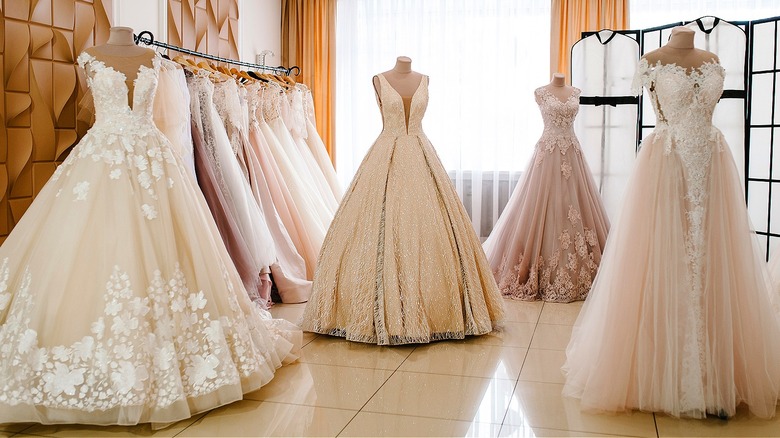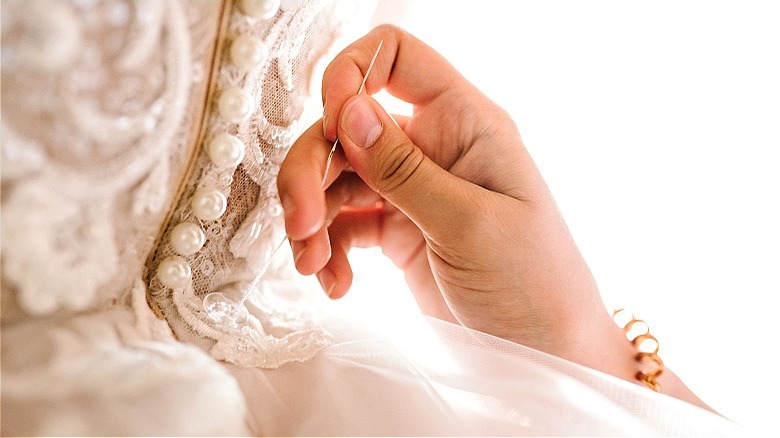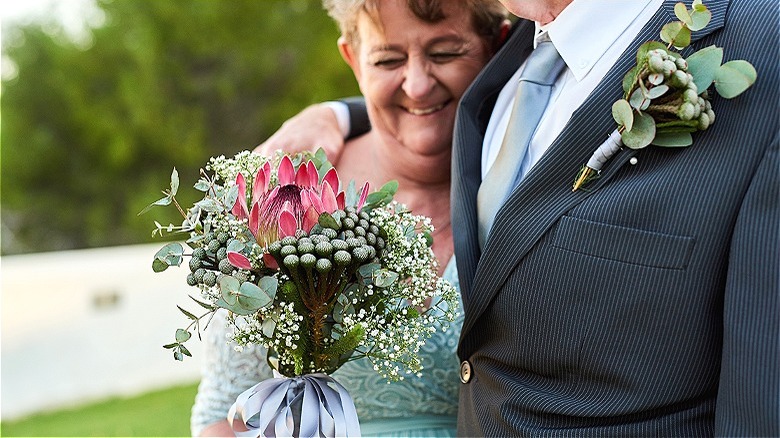The Average Price Of A Wedding Dress May Surprise You
If you're one of the almost 40% of people who got engaged over the holidays (aka engagement season), then you're probably planning your upcoming nuptials. From venues to food to deposits, wedding planning can not only be stressful but also expensive. In fact, according to The Knot's Real Weddings Study, the average cost of a wedding in 2023 was $35,000. However, among the many expensive things that can add up during wedding planning, perhaps none are as important as the bride's dress.
Wedding dresses didn't experience the same price fluctuations and general volatility the rest of the wedding industry has in the last several years. In fact, the pandemic put a damper on everything from the guest size to the amount of destination weddings being thrown. While 2023 numbers showed a return to pre-pandemic wedding decisions, inflation has made many of those decisions considerably more expensive than they were. For instance, the average cost of a wedding in 2019 was $28,000 — $7,000 less than in 2023 — despite the fact that pre-pandemic weddings generally included larger guest lists and more vendors.
The increase in expenses is also largely due to the several years in which venues and wedding-vendors lost considerable business (there were over 1 million fewer weddings in 2020 than the year prior). So why did the wedding dress industry fare so much better? While some couples might have decided to ease up on venues or florals in the face of the pandemic, most wouldn't give up their wedding dress.
Hidden wedding dress costs
The Knot's Real Weddings Study found that the average wedding dress cost around $2,000 in 2023 (compared to an average of $330 spent on the groom's attire). This was only a slight increase over 2022 dress costs ($1,900) and 2021 ($1,800). However, while the retail price of a wedding dress can widely vary depending on a bride's specific budget and/or designer preferences, it's important to also consider any alterations and/or customizations that might be needed or wanted for a selected dress.
Alterations can add to the overall cost of a bride's dress on top of the added expense of additional fittings and/or adjustments. Customization options can also add to the total cost, depending on the complexity of what's wanted. Another thing worth considering is that not all brides want to wear ready-to-wear retail dresses. In fact, per The Knot's survey, 20% of 2023 brides actually elected to have fully custom-made dresses made for the occasion. Brides choosing to go this route should be aware that most custom-designed dresses will generally cost significantly more than the average retail dress price.
Another potentially forgotten cost that can add on to what you spend on a wedding is the brides' additional clothing items. Since most brides will generally want to include bridal accessories like, say, a veil, the entire ensemble should be factored into the wedding dress budget. It's increasingly common as well for brides to wear different reception outfits, which can further inflate a bridal budget.
The future of wedding dresses
According to Zion Market Research data, the market size for bridal gowns was valued at $44.2 billion in 2022, and expected to continue growing, reaching a projected $73.2 billion by 2030. This is due to a number of factors, including easier access to online shopping and virtual try-on platforms (although you might want to take these with a grain of salt; see our roundup of things you should never buy online). Plus, the rise in post-pandemic marriage rates have boded well for the industry. According to marriage rate data from the Centers for Disease Control and Prevention, the U.S. experienced a significant uptick in marriages in 2022 (12% to be exact).
However, it's worth noting that the industry might have an uphill battle in the future. Not only are fewer people willing to splurge on wedding gown expenses than in years prior, but overall marriage rates in the U.S. have been steadily declining for decades. In fact, as of 2021, a record-breaking 25% of 40-year-olds in the United States had never been married at all, per the Pew Research Center's analysis of Census Bureau data.
Even more interesting, though, is that about a quarter of 40-year-olds who had not married in 2001 had done so by age 60. This adds a demographic shift that's sure to change the wedding industry as a whole. While 98% of The Knot's 2023 female survey respondents reported wearing a wedding dress for their big day, as age demographics and spending habits shift and marriages move to later in life, or not at all, the chokehold concept of a white wedding gown might eventually become a thing of the past.


